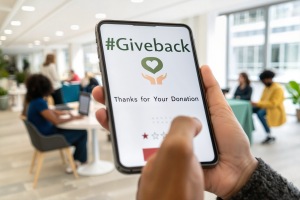In the face of a rapidly changing technology environment, nonprofit organizations should take the time to identify and incorporate significant trends that can help them improve their core activities and achieve their main goals. In this article, we will discuss the most important technology trends that nonprofits should be aware of and exploit in 2025.
Donors using mobile devices are demanding more attention
 The trend of donors preferring to use their mobile devices to easily make donations will continue to grow in 2025. As a result, your organization should tailor its content to be mobile-friendly, and there should be a variety of mobile payment and text-to-give options available.
The trend of donors preferring to use their mobile devices to easily make donations will continue to grow in 2025. As a result, your organization should tailor its content to be mobile-friendly, and there should be a variety of mobile payment and text-to-give options available.
In addition, your nonprofit organization should invest more time and resources into developing and executing SMS-focused marketing campaigns for donations.
Greater focus on non-traditional online platforms
After a bitterly contested election season with polarized factions still engaged in conflict, there is an opportunity for nonprofit organizations to use technology tools to help create a greater sense of community. One area that nonprofits should focus energy on is in building online community platforms that provide a digital meeting place for people with shared interests and goals. In the current tense environment, individuals are seeking refuge in places where visitors have like-minded values and interests.
Traditional social media platforms, while necessary and useful to reach members and potential donors, can sometimes amplify division and inundate visitors with ads and undesired content. As an important complement, your nonprofit organization should look to build a customized online community platform to achieve better results. These influential platforms provide a virtual location where your target audience can interact and share information in a safe and nurturing setting that encourages communication, education, and more focused attention on the goals of your organization.
AI’s importance will continue to grow
 AI’s power, versatility, and affordability will all improve in 2025. As a result, your nonprofit organization should seek to utilize AI-powered tools as much as possible. Some useful AI functions include:
AI’s power, versatility, and affordability will all improve in 2025. As a result, your nonprofit organization should seek to utilize AI-powered tools as much as possible. Some useful AI functions include:
-Essential assistance with content creation including text, graphics, and videos.
-Human-like chatbots to guide members and potential donors on your website.
-Enhanced analysis of donor and constituent data to better predict behavior and improve donor recruitment and fundraising activities.
-Optimized resource allocation by streamlining repetitive activities such as client onboarding and updating donor lists. This feature will allow your staff to focus on more important tasks such as building stronger relationships with members and finding new donors.
–Improved workforce talent acquisition. AI tools will help your organization identify and reach a larger pool of preferred candidates on a wide variety of recruitment platforms.
More effective donor campaign decisions based on comprehensive data analytics
 Using the power of AI and technology found in CRMs and membership management systems (MMS), your nonprofit organization will be able to better utilize the valuable data you collect from donors. These systems enable your company to analyze donor data such as the platforms used for donations, how often they gave, and how many different marketing channels were used to obtain a donation. With this crucial insight into donor behavior, your organization will be able to effectively evaluate your fundraising and marketing campaigns and better allocate your limited resources.
Using the power of AI and technology found in CRMs and membership management systems (MMS), your nonprofit organization will be able to better utilize the valuable data you collect from donors. These systems enable your company to analyze donor data such as the platforms used for donations, how often they gave, and how many different marketing channels were used to obtain a donation. With this crucial insight into donor behavior, your organization will be able to effectively evaluate your fundraising and marketing campaigns and better allocate your limited resources.
Data analytics also provides your organization with the opportunity to gain a better understanding of what topics and issues interest your current members and prospective donors. With this insight, your organization can send out personalized marketing campaigns that reinforce what your target audience is most concerned about, resonates with them individually, and fosters a deeper connection. These efforts will result in higher retention and acquisition and will raise the level of donor and member engagement.
A worsening cybersecurity environment demands better technology and expertise
The cybersecurity threat to your nonprofit will be more acute in 2025. While AI has been beneficial in developing more powerful cybersecurity tools, it has also made it easier for more bad actors to launch a greater number of complex cyber-attacks.
 In addition, IT security experts note that cybercriminals are devoting more time targeting nonprofit organizations for a variety of reasons. First, they recognize that many nonprofits don’t have the dedicated staff or budgets to maintain effective cybersecurity. Second, they see an opportunity to obtain the sensitive information and breach the networks of the wide variety of donors and members working with nonprofits.
In addition, IT security experts note that cybercriminals are devoting more time targeting nonprofit organizations for a variety of reasons. First, they recognize that many nonprofits don’t have the dedicated staff or budgets to maintain effective cybersecurity. Second, they see an opportunity to obtain the sensitive information and breach the networks of the wide variety of donors and members working with nonprofits.
As a result, your nonprofit should take the time to assess and make use of the latest cybersecurity tools. You should also ensure that your employees have ample training and follow strict protocols on how to maintain good cyber hygiene and protect personal data. In addition, your organization should use data security measures such as encryption and multi-factor authentication and take advantage of third-party cybersecurity assessments.
Your organization should also make it a priority to ensure that any partners or vendors with access to your network have their own strict data security policies in place. Cybercriminals can often get around the strong cyber defenses of organizations through the security vulnerabilities of their partners.
Consult with an IT Support partner with proven experience helping nonprofits
 To better understand and exploit these important technology trends in 2025, we recommend you work with a proven IT Support partner like Network Depot. A dependable expert on IT and nonprofits will help your organization assess your IT weaknesses and incorporate the advantages presented by these trends.
To better understand and exploit these important technology trends in 2025, we recommend you work with a proven IT Support partner like Network Depot. A dependable expert on IT and nonprofits will help your organization assess your IT weaknesses and incorporate the advantages presented by these trends.
Your reliable IT partner will provide valuable advice and implement the tools and methods necessary for improved donor recruitment and member communication as well as enhanced cybersecurity and more efficient internal operations.
By working closely with an IT Support partner to understand and maximize the benefits presented by these trends, your nonprofit organization will be able to achieve your unique goals more effectively.